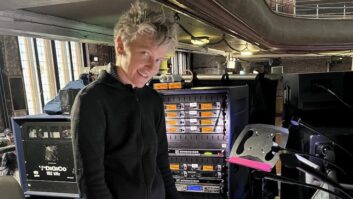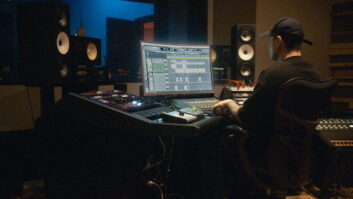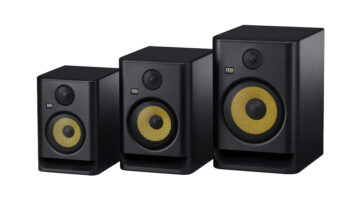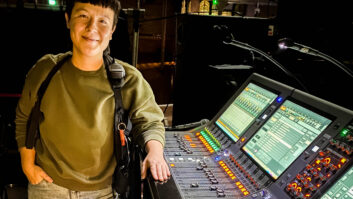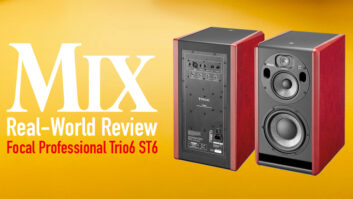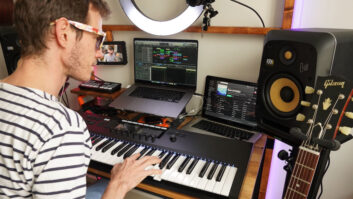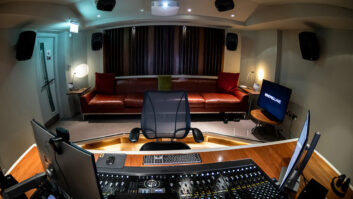In this special live sound issue of Mix, readers will find plenty of useful information on audio products designed for live sound applications. But none of this cutting-edge technology gear runs itself (yet), so we decided to balance the product coverage with some stories from the trenches. Four experienced monitor engineers-Robert Kosloskie, Paul Owen, Rene Spooner and Vish Wadi-were kind enough to reveal some of the tips and tools they use in their craft. (For some background, see “Our Panel of Experts,” page 82.)
Perhaps not surprisingly, each engineer’s equipment choices tended to reflect his working style. For example, asked if he prefers any particular type of high-frequency driver for wedge monitors, Wadi replies “No, as long as it sounds good. I’m not one of those guys who go by [model] numbers and say, ‘This is what I want.’ I’m very open-minded to try new things, and if I don’t like it, I go back to what I know. I’m also from the old school-I still love [Sennheiser] 421s for drums. At the same time, I don’t mind trying new things out.”
Owen notes that his selection of high-frequency driver typically depends on the application. “I’ve gone through so many different drivers and diaphragms, everything from Electro-Voice DH2As to JBL 2445s. I still think the JBL is a nicer-sounding, high-frequency unit, and it’s much more robust, especially for drum monitors. I had some 212 [monitor cabinets] I used for Lars [ulrich of Metallica] in his huge drum monitor setup, but the DH2As just wouldn’t take the beating, so I ended up putting some JBLs in there, some 2445s, and I’ve never lost one. I was losing one every other show, before.”
When choosing amplifiers, however, Owen is much less critical. “There are so many high-quality amps out there, from Crest and Crown, for instance, that I don’t have a preference, to tell you the truth,” he says. “As long as it makes the wedge work, I don’t really care.”
On the subject of monitors, both Owen and Wadi agree on the deserved success of the Clair Bros. 12AM wedge monitor. “I like 12-inch [wedge monitors] because I like a nice tight stage and smaller wedges,” says Wadi. “I love the way the 12AM sounds. Fifteens, for some reason, I’m not really fond of. I can’t get that nice, tight sound. I have, but not the way I like it.”
“Clair Brothers always had an amazing reputation for their monitors,” says Owen. “The 12AMs have been used constantly, by everybody. I was always prone to using DMLs, which I used on quite a few tours, the E-V DMLs. And SSE, the company in England we use quite a lot, had a Beta Max, made from the same design, which I think is a great-sounding wedge. I do think that for vocals, the smaller 12 wedges are definitely the way to go.”
Kosloskie notes that the needs of the production often dictate equipment choices. Reba McEntire has recently been touring an autobiographical play depicting her experiences in life and music, “a pretty big production,” says Kosloskie. Because of the show’s format, Kosloskie must mix for three different mic setups: “For the first part of the show, I’m using the Danish Pro Audio 4060 lavalier. It’s a little omnidirectional, and it’s flesh-colored, so we hide it in her hair, on her forehead,” he explains. “Then, on the same wireless system, when she comes to the concert section of the show, I’ve got the Crown CM-311E headset mic. That’s a really good headset mic. I keep trying new headset mics, but I haven’t found one yet that beats that one as far as the audio and the rejection. It’s just killer. And we also use the Shure uHF hand-held system, with a Beta 58 on it, during one song of the show.”
Owen notes that he has recently changed Metallica’s vocal mics, from the Shure Beta 58 to the Audio-Technica 4054, a cardioid condenser. “I think the pattern’s as tight as a 58,” says Owen. “It’s just got a better sound quality. A 58 is just a great all-round microphone, and you can knock them around and they’ll still work. But now, with in-ear monitors, you can actually get a lot more quality in the mix. When whole stages are completely dead-no ambient sound apart from the back line-the selection of microphones is becoming far more critical. Rather than just going with whatever gets the loudest volume with the least amount of feedback, I think people are really looking for quality now.”
IEMS ADD CONSISTENCY
A fundamental mark of quality is consistency, and one advantage of in-ear monitors (IEMs) is that they are relatively unaffected by daily changes in performance acoustics. “By having the in-ears, our environment is basically with us everyday,” says Kosloskie, referring to the current Reba McEntire production. “All we have to do is adjust to what the room does to us. It’s pretty much the same.”
Kosloskie makes extensive use of board automation, both to manage a complex show and to make up for a lack of preparation time. “We’ve got ten trucks out with us now: set, lights, scenery, props and audio, and it takes all day to load in the production. Audio gets very little time,” he notes. “I have a lot of cues in the show, and whenever we don’t do our play, they have a repertoire of songs that they just pick out of the hat. We’ll get a set list before the show, so I run through all my songs and write down the cue numbers. Then I just scroll up that number, punch it at the end of each song, and we’re all set for the next one,” he explains.
As Spooner observes, IEMs have democratized the stage-the singer is no longer completely at the mercy of “a bass player with 800 pounds of equipment and a guitar player with his huge stacks. If the production manager/lighting guy goes with a sound company that doesn’t have great monitors or a great monitor engineer, the singer never seems to get a fair shake,” says Spooner. “But now the singer can walk in with his rig under one arm and have really sterling sound for himself and his vocal and not have to worry about screaming to hear himself-or screaming at the monitor guy for making feedback.”
Owen points out that changing a drummer over to IEMs can significantly ease the FOH mixer’s job. “He’s got no interference with the drum monitor blasting down the front vocals,” says Owen. “It’s surprising how much it changes things. It’s night and day. In outdoor shows, especially, where the drum monitors are blasting away right down the middle, the engineer out front will start balancing his mix around this center sound off the drum monitor. Because it’s pointing right at the mix position. [With IEMs] he doesn’t have that.”
Of course, in-ear monitors come at a price, which includes a significant investment in dynamic control devices. “We use Aphex Dominators on each mix output, before it goes to the amp or the transmitter,” says Kosloskie. “Right now, I’m using the dual Summit Audio compressor, the DCL 200s, on Reba’s voice.”
“I guess I’m from the old school, again,” says Wadi. “I love the dbx units. I like 160xs on vocals and the 900 Series for the other stuff. When I’m using an ATI Paragon, I use the compressors on the board for everything except for vocals. The one on the ATI’s not fast enough for me.”
“With the in-ears, bring on as many channels of compression as you can get,” says Spooner. “Let’s compress everything. Let’s make everything really fit into its space in the headphone mix.”
By contrast, for wedge monitor mixes Spooner’s philosophy on EQ is “less is more:” “I like to go with as little EQ as possible. Let’s turn it on, turn it up to the desired volume and see where we are. With the EAW wedges, you turn them on, they sound good, [and] you have to do minimal EQ; you don’t have to make a bunch of compensations. Someone else has done that-they spent a bunch of money on R&D. But we’ve got some other wedges, double 12s with a 2-inch, and there are some characteristics you should take into account before even turning them on. Some low mid that you just have to get rid of.”
Simplicity also figures in Wadi’s setup. “I like getting all the mixes sounding the same, whether they’re wedges or ear monitors. And I stop there. unless somebody wants something way different,” says Wadi. “But almost everybody I’ve worked with so far, it’s been all right, having kind of a flat sound. If you start from a flat sound, then when you EQ a kick drum, no matter where you put it, it sounds the same. But let’s say somebody wants it really bright, and it’s the only thing in that mix, then I’ll make the mix brighter.”
THE CONSOLE
On monitor console preferences, there was a general consensus that today’s better mixing consoles are more than adequate for the job. “Out of personal preference, I don’t think there’s a desk on the market as good as the [Midas] XL4, regarding EQ,” says Owen. “But at the same time, I don’t mind using the [Yamaha] PM4000, but I just don’t think the facilities are as good. It’s a nice-sounding board for in-ears, but I don’t think it’s a real good hard-driving board as regards wedge monitors.”
Wadi is currently using a Paragon II with Sting. “When I first started, the Soundcraft 400B was the only board,” he recalls. “We’ve come a long way. The Ramsa [840] was a good board, and I love the way the [Midas] XL3 sounds. And the [Midas] Heritage 3000 is a good-sounding board. I must say that.”
Wadi is less enthusiastic about Midas’ flagship mixer, the XL4. “The XL4 is a good-sounding board, but I don’t trust it. It went down on me twice, and sometimes that’s all it takes,” says Wadi. “I’d rather have stuff without programs-they’re called programs-because in the XL4, if I lose programs, I lose all my mixes. The ATI is a good board, but I wish it had a little bit more punch, like the XL3. But I’m coming around to it and I’m beginning to find the sweet spot in it.”
UNDER PRESSURE
Asked to name one factor essential to success as a monitor engineer, all those interviewed picked artist communications. “The whole thing of monitors is, 50 percent of it’s technical ability-being able to do the job-and 50 percent of it is definitely artist relationships,” says Owen. “There’s so many monitor engineers out there who are just getting through the technical side of the gig, but because their face fits and they get on well with the band, they get through it. It depends how you deal with the pressure.”
Wadi is by no means short of technical chops-he holds a bachelor’s degree in electrical engineering-but he insists on a close working relationship with the artists he works for. “They’ve all been pretty good. If they don’t [communicate], I just have to tell them, ‘Look, we need to have some kind of communication thing going,'” says Wadi. “I’ve been lucky, being able to read people. I’ve been working for Sting for long enough, I can look at his facial expression and know something is wrong. And he’ll tell you.”
Spooner holds that being open and honest counts. “I’ve always been one to just jump right out onstage with them as soon as they start playing, and that a lot of times, will help them communicate with you, if you go and stand right next to somebody as opposed to staying at the console,” he says. “I make a point of having a private conversation with the artist, letting them know that I’m there to help them. Communication with the artist has always been the most important thing to me. That’s always the biggest thrill of my job, as having the one-on-one communication with the artist during the show. Right there, standing right there, he looks right over at me, and we’ve got our signals worked out, and he gives me the little signal, I make it better for him, and the show is better. That’s where it’s at, and if that’s not happening, if you don’t have that communication, then it’s no fun for anybody.”
On the McEntire show, Kosloskie uses the IEM system as a personal communications channel to the artist. “If she gets stuck on a line, boom, I can ram them out to her on the talk back mic, and just her, nobody else, hears it,” he explains. “And when she goes for her clothing changes, I can solo her microphone and listen in on my ear monitors, and I can talk back to her. I can talk to her, she can talk to me, and we can fix any problems. If it’s real muddy, or if it’s too boomy, or if the high end’s frying on her, she can describe that situation to me and I can try and fix it.”
Owen notes that verbal communication over IEMs between artists and production crew becomes essential when the monitor engineer is out of sight. “I’ve been so many times on cameras now, it’s unreal,” he says. “With the in-ears, it’s not as critical-you don’t have to watch for mics getting thrown in front of wedges. Plus, it makes it easier from a psychological point of view. When bands see monitor engineers on the side of the stage, they’re always a good scapegoat to go and scream at when they want something, if things don’t go right. [Metallica] did 17 months in the round, and they never saw me all night and very rarely asked for anything, because they probably looked a bit stupid talking into a camera, waiting for a light to flash to acknowledge their signal. And all of a sudden, when we went into stadiums and I’m back on the side of the stage, it was ‘up, down, up, down.’ Just because they see you, they ask you for it.”
Though Owen’s jibes about Metallica’s monitoring demands are affectionate and tongue-in-cheek, he points out that monitor engineers must often deal with unreasonable requests and/or abuse. “Look at the guy who is doing Marilyn Manson, who throws mics at him and talks shit at him,” says Owen. “Marilyn Manson even ran over our monitor desk in Europe to get to his monitor engineer. Across our desk, which caused complete havoc. He could have ruined that whole show. And when you look at people like Axl Rose [Guns N’ Roses], were bar-coding engineers, because they were going through them so regularly. There’s some horror stories out there, I know that. Some real horror stories.”
